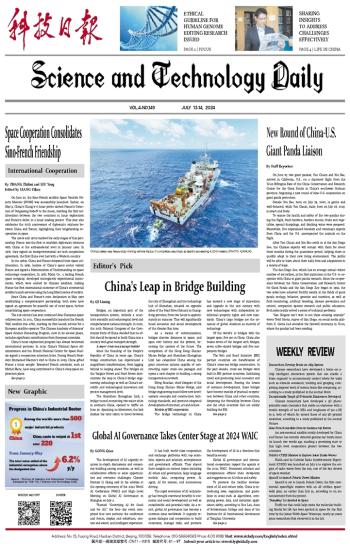
 Sharing Insights to Address Challenges Effectively
Sharing Insights to Address Challenges Effectively Ethical Guideline for Human Genome Editing Research Issued
Ethical Guideline for Human Genome Editing Research Issued Space Cooperation Consolidates Sino-French Friendship
Space Cooperation Consolidates Sino-French Friendship PHOTO NEWS
PHOTO NEWS New Round of China-U.S. Giant Panda Liaison
New Round of China-U.S. Giant Panda Liaison China's Leap in Bridge Building
China's Leap in Bridge Building WEEKLY REVIEW
WEEKLY REVIEW New Graphic
New Graphic Global AI Governance Takes Center Stage at 2024 WAIC
Global AI Governance Takes Center Stage at 2024 WAIC
Bridges, an important part of the transportation system, embody a country's scientific and technological level and comprehensive national strength. In 2022, the 20th National Congress of the Communist Party of China decided that no effort should be spared to build China into a country with great transport strength.
A super cross-sea passage builder
Since the founding of the People's Republic of China 75 years ago, China's bridge construction has experienced a magnificent transformation, from lagging behind to leaping ahead. The bridges on the Yangtze Rivers and Pearl Rivers demonstrate the leap in China's bridge engineering technology as well as China's scientific and technological innovation and project management level.
The Shenzhen-Zhongshan Link, a bridge-tunnel connecting two major cities in southern China, opened to traffic on June 30. Spanning 24 kilometers, the link slashes the time taken to travel between the city of Zhongshan and the technology hub of Shenzhen, situated on opposite sides of the Pearl River Estuary in Guangdong province, from two hours to approximately 30 minutes. This will significantly boost economic and social development of the Greater Bay Area.
As a means of communication, bridges shorten distances in space, and span over history and the present, becoming the carriers of the future. The completion of the Hong Kong-Zhuhai-Macao Bridge and Shenzhen-Zhongshan Link has catapulted China among the great innovator nations capable of constructing super cross-sea passages and opens a new chapter in building a strong transportation network.
Meng Fanchao, chief designer of the Hong Kong-Zhuhai-Macao Bridge, said bridge engineering must follow new development concepts and construction technology standards, and promote integrated development of structure, art and culture.
Models of BRI cooperation
The bridge technology in China has entered a new stage of innovation and upgrade in the 21st century with new technologies with independent intellectual property rights and new standards. China's large bridges are the cynosure of global attention as marvels of technology.
Of the world's 10 bridges with the largest span, five are in China. China also boasts seven of the longest arch bridges, seven cable-stayed bridges and five suspension bridges.
The Belt and Road Initiative (BRI) partner countries are beneficiaries of China's cross-sea bridge construction. In the past decade, cross-sea bridges were built in BRI partner countries, facilitating travel and promoting local economic and social development. Bearing the dream of common development, these bridges have become models of practical cooperation between China and other countries, deepening the friendship between China and the other countries that are jointly building the BRI.
The Sultan Abdul Halim Muadzam Shah Bridge, the second cross-sea bridge in Penang state, Malaysia, is a landmark project for the internationalization of China's bridge construction technology. The 24-km bridge, the longest in Malaysia, has improved traffic between the island of Penang and mainland peninsular Malaysia, and shows the competitiveness of Chinese enterprises in the global engineering market.
However, Chinese bridge technology needs increased investment in R&D to maintain competitiveness and innovation ability, according to Xiao Rucheng, chairman of the Bridge and Structural Engineering branch of China Civil Engineering Society.
In the future, with the development of science and technology in China, Chinese bridge technology will aim to make greater breakthroughs in intelligence, green construction and operation, and high efficiency, making greater contributions to global infrastructure construction.

 Next
Next



